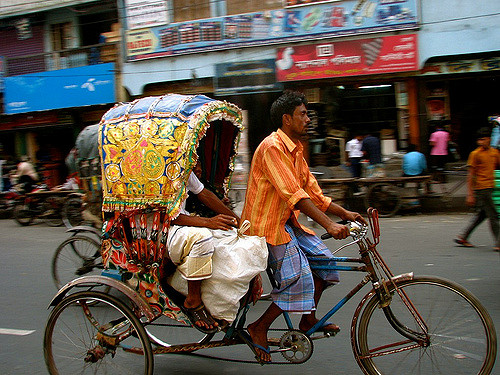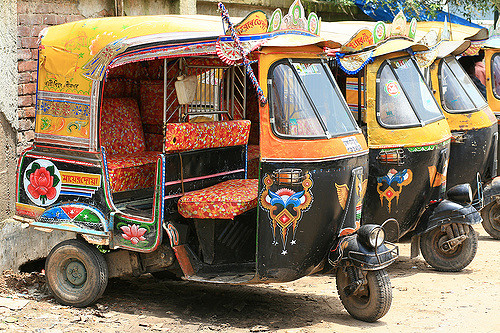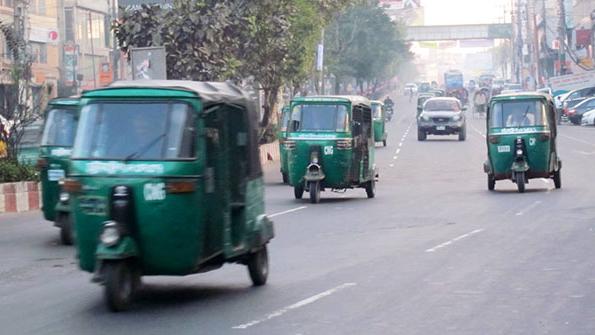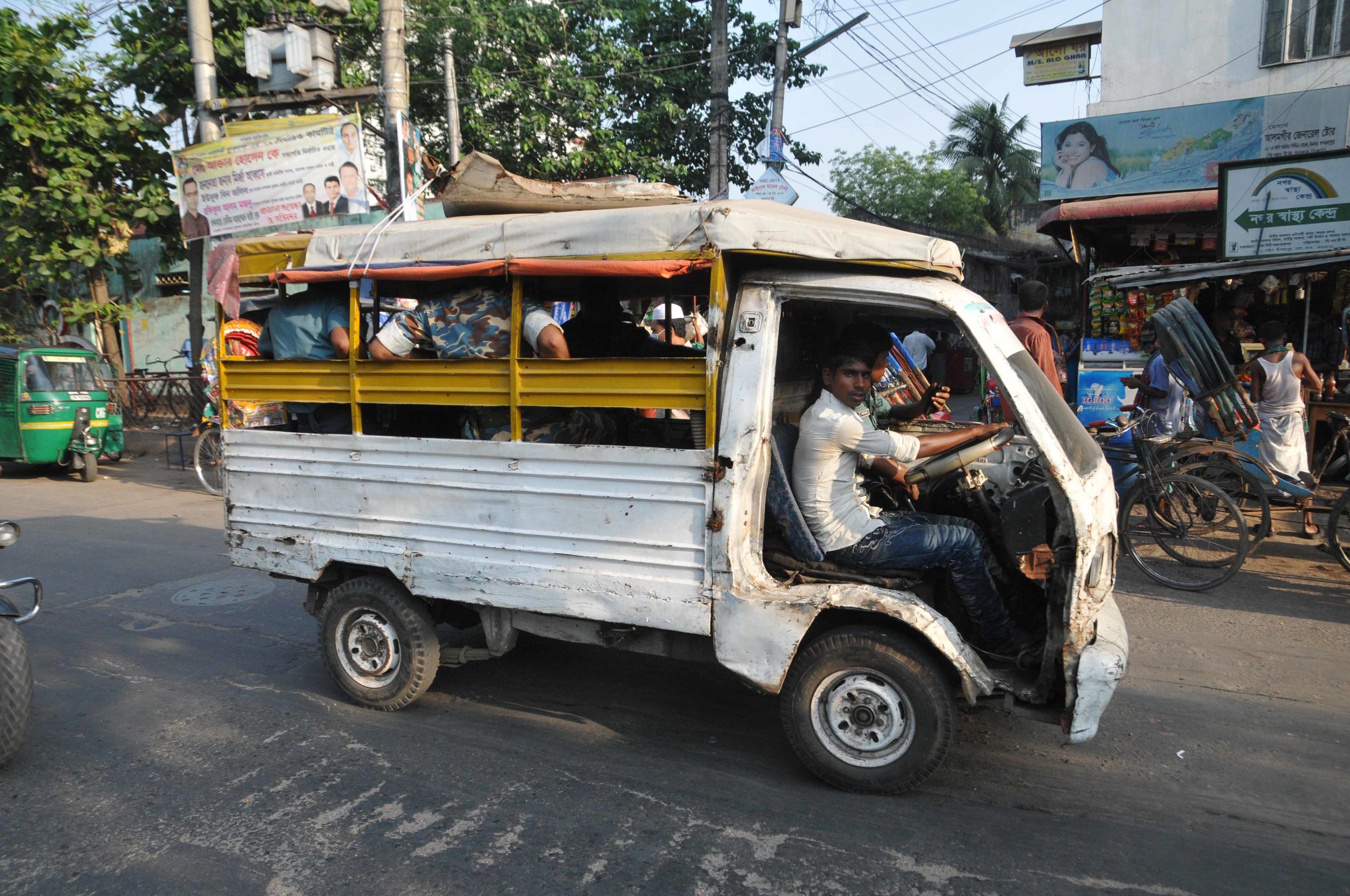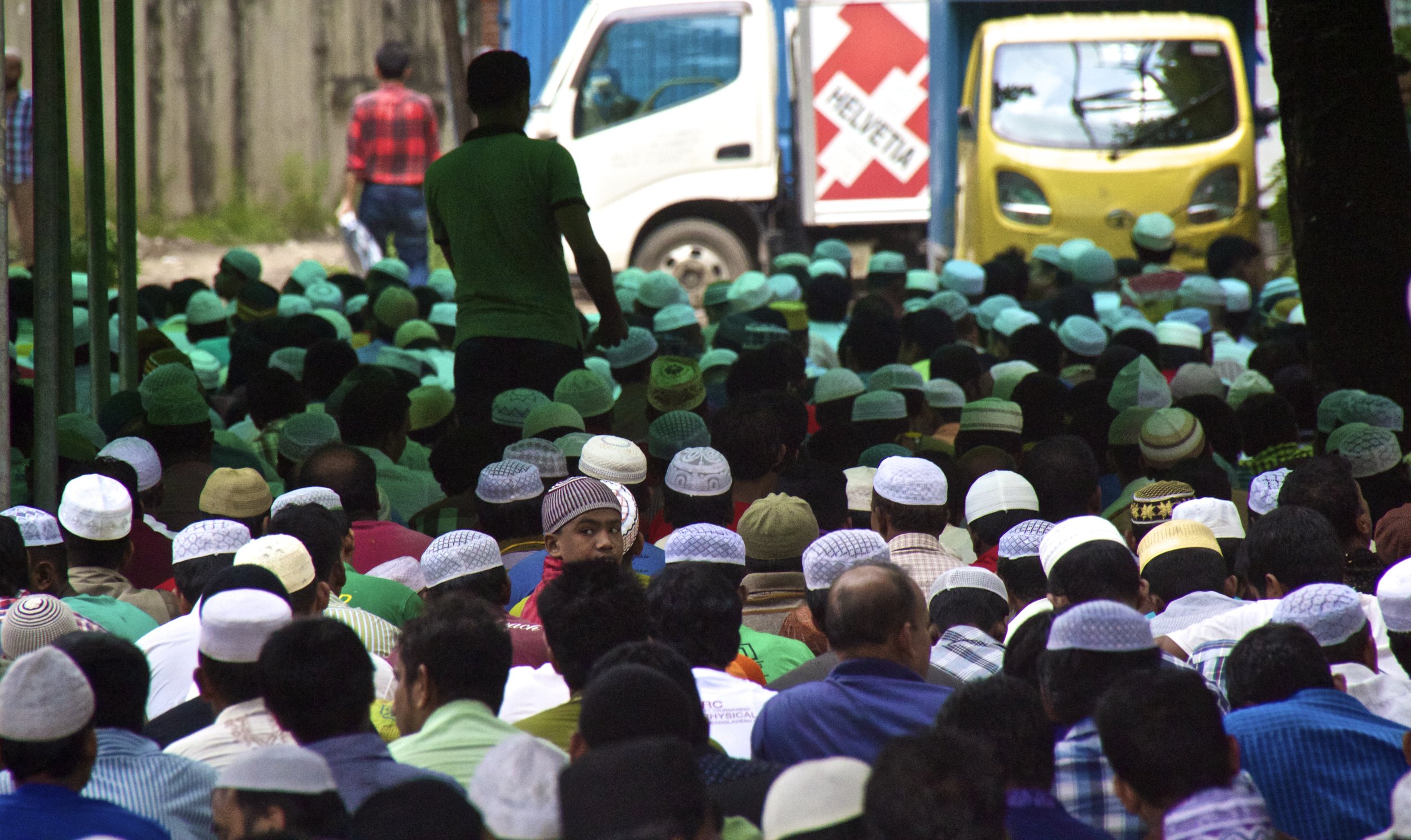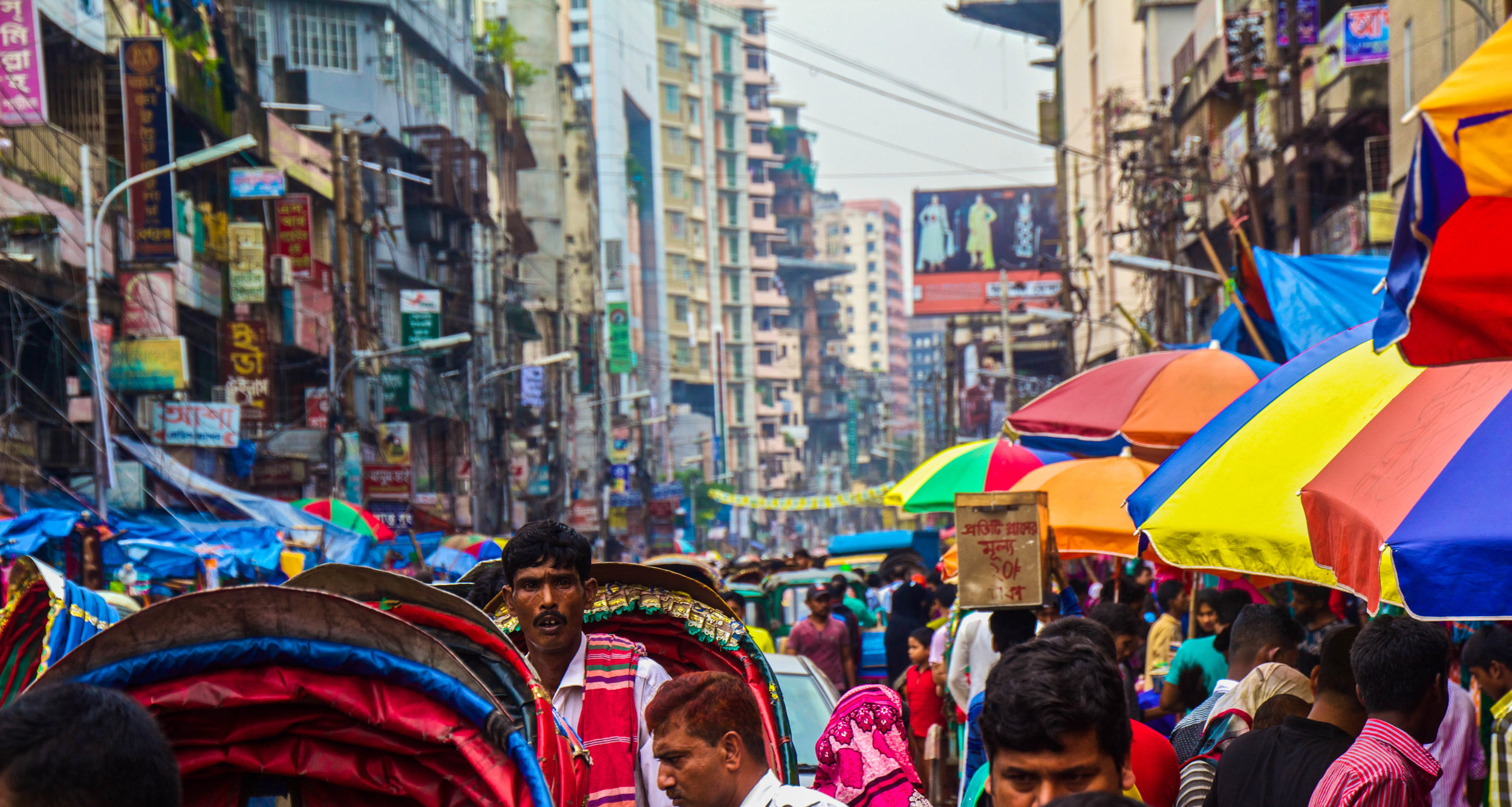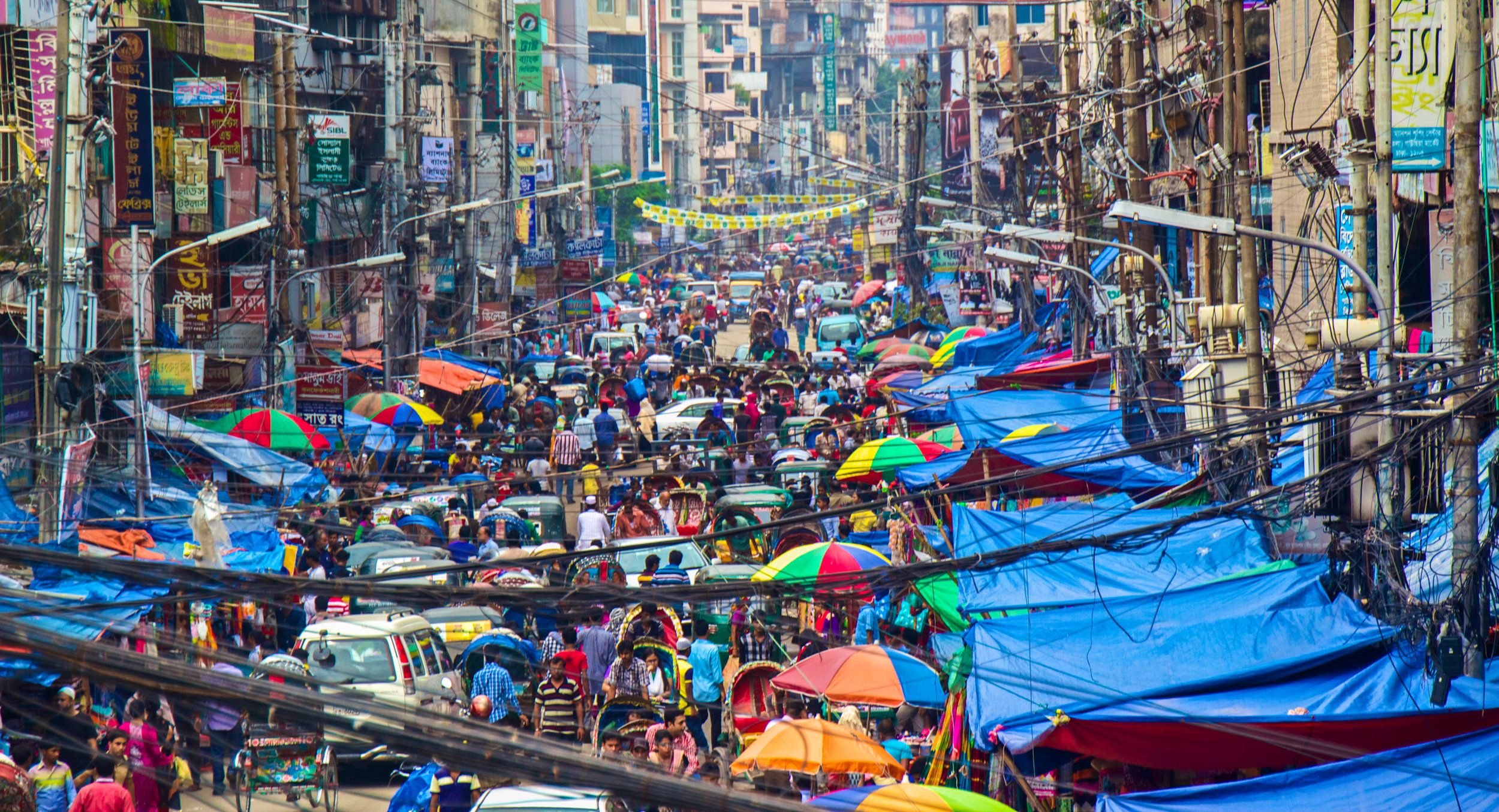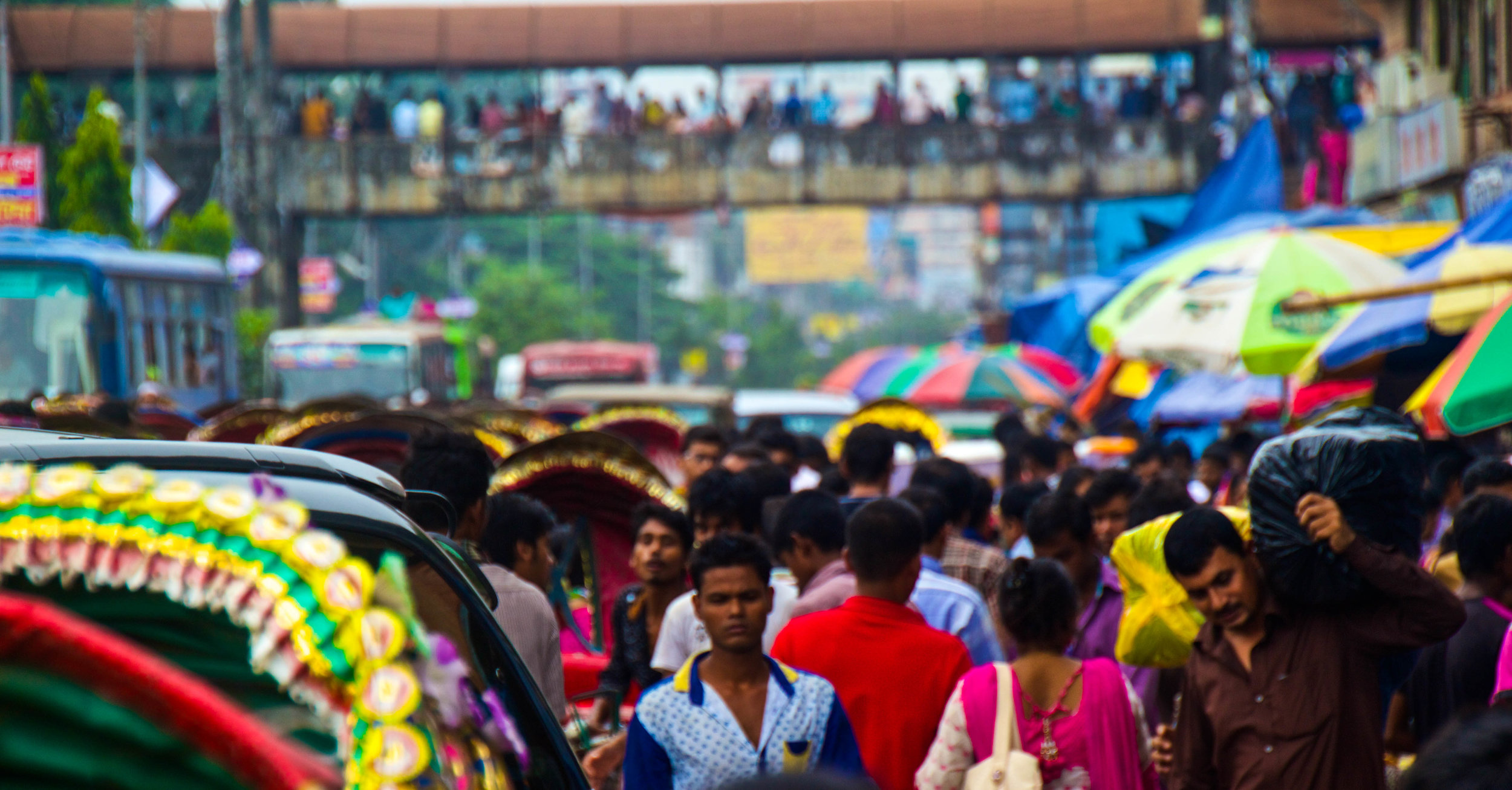


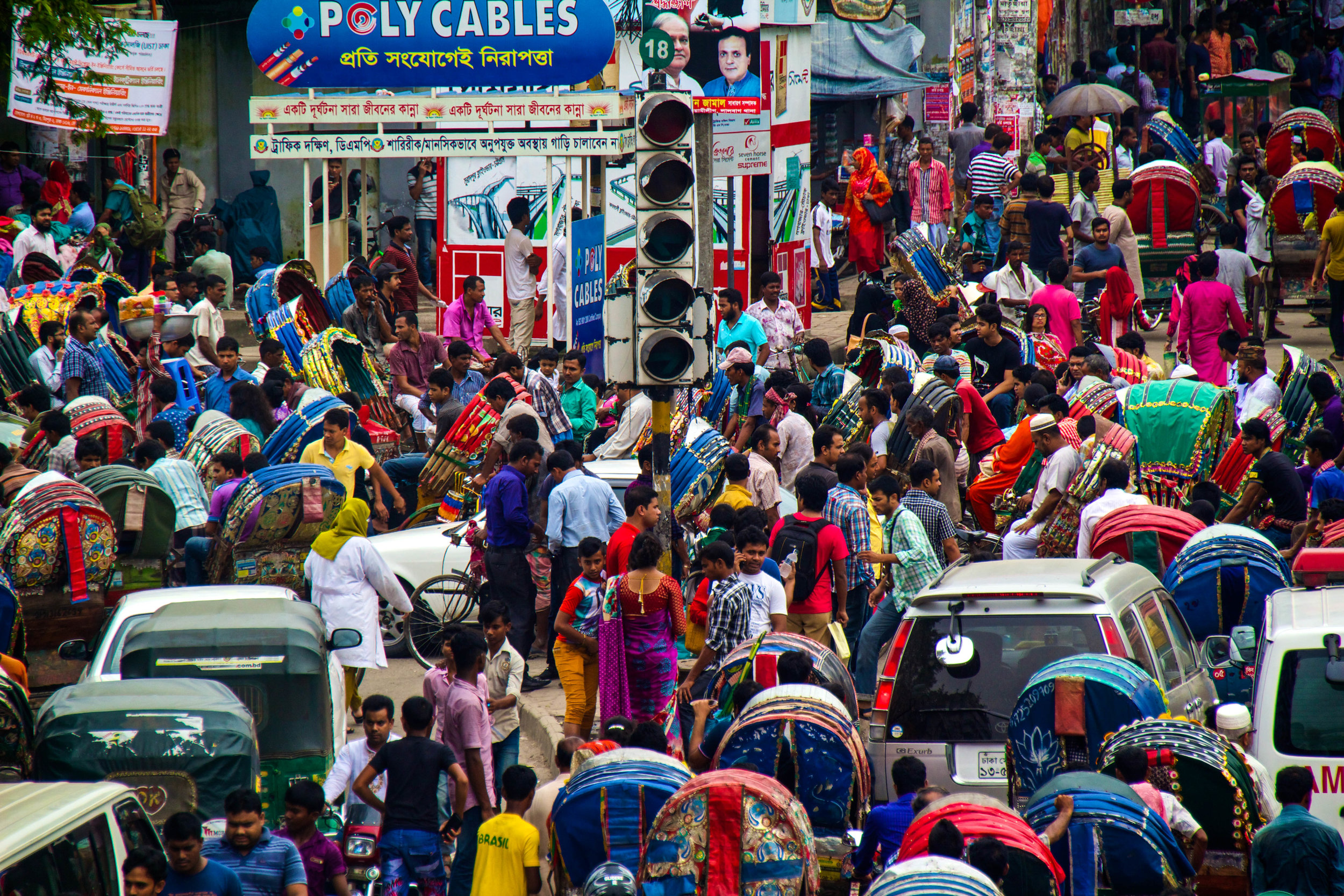





Peter's Guide To Dhaka
"The Most Unlivable City In The World"
Peter's Guide To Dhaka
"The Most Unlivable City In The World"
Welcome to your guides to Dhaka, Bangladesh: "The Most Unlivable City In The World." It's very cool that you're interested in this crazy place! Here's a quick overview of what you're getting yourself into with this article...
The Dhaka Guide Index
Click One & Zoom Down
1. An Introduction to Dhaka
(Plus the narrative of my arrival)
2. TRANSPORTATION IN DHAKA
(You've got a lot of options, none of them great)
3. NEW MARKET
(Where Abercrombie shirts go to die)
4. GULSHAN
(This neighborhood is Dhaka's 1%)
5. OLD DHAKA
(The city of magnificent ruins)
6. BANGLADESHI FOOD
(A very abridged guide)
7. DHAKA, OVERALL
(A few final thoughts)

An Introduction To Dhaka
Bangladesh's over-crowded, politically-unstable, violent, flood-prone, impoverished, chaotic, vibrant, colorful, amazing capital city.
An Introduction To Dhaka
Bangladesh's over-crowded, politically-unstable, violent, flood-prone, impoverished, chaotic, vibrant, colorful, amazing capital city.
Dhaka, Bangladesh.
Holy shit guys.
Yes, Dhaka has consistently been ranked as the #1 most “unlivable” city in the world by publications like The Telegraph, Business Insider & etc. It is mostly competing with Harare, Zimbabwe for that title. I’ve been here for a little while now, and I can 100% understand why. Thanks to overcrowding, traffic, and muddy rivers running through the streets, it takes 3 hours to get from one side of the city to the other on a normal day. The commute is stressful, deafeningly loud, and always wet, due either to sweat or torrential rain. Kind of makes you just want to never leave home, if possible.
But let’s just start from the beginning.
When my Pakistani cab driver dropped me off at the airport in Rangoon, I paid him, thanked him, and was about to shut the door when he said “Be careful!”
“…sorry, what?” I said, stopping the door from shutting.
“Be careful. I think Bangladesh not safe anyone,” he said, in broken English.
Thanks for the pep talk bro!
As an old timer of Pakistan and Burma, I think it was safe to say that this guy had seen a thing or two in his day, including Burma’s the notorious military coup of the 1960s. If HE thought Bangladesh was going to be dangerous, then things were looking grim.
Thanks to my food poisoning, I had had to switch from Biman Bangladesh Airways to Bangkok Airways. Amazingly, Biman promised a full refund for my ticket within 2 billing cycles, but that is still pending. I’ll believe it when I see it. [EDIT: My refund was received in full, as promised]. Waiting for my flight to Dhaka, I was feeling very stressed. I was still feeling a quite sick from my hellish last 36 hours in Burma. On top of that, there was a large storm pelting the giant glass windows of Suvarnabhumi Airport with raindrops the size of gumballs. It was going to be a bumpy ride. Deep breaths Peter, deep breaths.
Bangkok Airways did their best to serve me a 3 course meal over the course of each of my short flights (Rangoon à Bangkok / Bangkok à Dhaka). During the final leg of the trip we flew through a pretty scary storm. The turbulence was intense. The Bangladeshi man next to me and I looked at each other as we tried to keep our drinks from spilling, fear in our eyes. The man actually turned out to be very nice. He wrote down his cell phone number and told me to call him if I needed anything.
I was surprised by how nice he was to me, even after I told him that I was American. A few friends of mine, who had been cellmates with a group of Bangladeshi jihadists when they were thrown into Thai prison together (that’s another story, but not mine to tell), had been pretty adamant that all Bangladeshis hate Americans. Obviously their survey pool was a bit biased, but nevertheless, this worried me. In fact, nobody had much good to tell me about Bangladesh. People love to say good things about these sorts of places to show how cool and worldly they are, but this was the first place I’ve ever gone where people told me unanimously bad things.
Things weren’t looking up when I got off of the plane. I waited in line for my visa for a total of 2.5 hours. There was a massive group of Chinese tourists blocking our entry into the country. At the front of the line was a little table with 2 Bangladeshi guards. One of them was writing all of their information down, by hand, into a spiral bound notebook. The other was shamelessly picking his nose. It costs 51 USD for a visa on arrival.
“Sooo any recommendations for things to do in Dhaka?” I asked the Kazakh man next to me in line that I had been talking to. He had spent a month here at some point in the past.
“Nothing. Stay in your room,” he said with a laugh. Then he told me about the last time he visited. The last time there were elections in Bangladesh there was a month of violent protests (I’ll get into this later). Dhaka came unhinged during this time. Bombs regularly exploded in the streets, people died. He recalled his taxi driver speeding through a crowd of angry protesters at 80 km/hour in order to get to the airport at 4am.
When I finally got my little “Dhaka” passport stamp, I walked out the door, expecting to see a little sign with my name on it. You see, during my time in Dhaka I will be working with a local NGO as a volunteer (I’ll also get to this later). That NGO was supposed to pick me up, but there was nobody there. By that point, my flight had landed 3 whole hours ago, so I figured that they might have given up on me. With no phone number to call, or phone to call it with, there was nothing that I could do at that point. I decided to get a cab to a random hotel instead and figure it out the next day.
Here’s the thing: once I walked out that door, I was going to be in Bangladesh for real. It’s kind of a crazy place as it is, but I found the airport in Dhaka to be a very intimidating to walk out of. Or, it was to me at the time.
When I walked out the door, there were two tall guards with AK-47s standing watch. They were both wearing full combat gear, camouflage and all. Their camouflage was a strange amalgam of colors, which included blue, yellow, and even some faded pink. That was different, but the real story was their beards. Both guards had thick Abe Lincoln chin-strap beards that were dyed red. Here’s a picture that I took later on to give you an idea of what I’m talking about.
They were pretty intimidating guys, but they were nothing compared to the sea of people that had their faces pressed against the bars a few meters in front of me. You see, the pick-up area of the Dhaka International Terminal is enclosed by bars to keep the crowds out. Through these bars, an onslaught of wide eyes stared at me like a cartoon of ‘monsters under the bed’. Arms and hands stuck out from the bars as if people were trying to worm through. Out beyond the bars was the long-awaited city of Dhaka. I might have been in over my head.
Mmmm… maybe there’s another way out. I turned around and walked right back inside. Luckily the person from the NGO found me, finally. He put a phone up to my ear and a girls voice said “Peter??? Oh my God! You stole my heart away!” (I think that that just meant that she was worried, not that she was in love with me. That would have been weird.)
We went out the same door and began pushing through the crowd to find the car. It took the man a solid 10 minutes of yelling into the phone and waving his arms in the air for the driver of our car to find him. It turned out that they had been a few meters away from each other the whole time. That’s how dense the crowd was.
Eventually we got to the car, and I watched, transfixed as Dhaka flew by outside. The city around me was growing more and more dense by the minute, but it wasn’t long before the paved roads fell away, and we were driving down dirt alleys. It had rained quite a bit that day, so at one point, when the road we were driving down began to turn into a river (like, an actual river), we were forced to turn back and find another route. It was a bumpy ride, but eventually we arrived.

Transportation In Dhaka
You've pretty much got 3 options...
Transportation In Dhaka
You've pretty much got 3 options...
Dhaka is huge, and the traffic is terrible. As I said before, to get from one side of Dhaka to the other takes about 3 hours. To make this commute, excluding the public buses (which you should stay away from) you basically have 3 choices for transportation. Which of these options is the best for any given journey across the city depends on 2 main factors.
First, how far are you going? If you need to traverse the full length of Dhaka, then you should definitely rule a rickshaw out. You want to be in some sort of motorized vehicle—otherwise it will take all day. If you are going somewhere that is not far from the beaten path and its close enough that crowding into the back of a hot truck bed sounds okay, a laguna may be your best option (and certainly your cheapest). However, in all other cases, you may need to get an CNG (or auto-rickshaw).
Second, how narrow are the streets going to be during your journey? The problem with Dhaka is that many of the streets are too narrow for anything other than Rickshaws (and walking). For this reason, it is not uncommon for a CNG to drop you off at the entrance to a particularly dense neighborhood. If your destination is still a long way away, you will need to catch a rickshaw from there. It's normal to changes vehicles once or twice in the same journey.
So now we've touched on Rickshaws, CNGs, and Lagunas—but what are these things?
1. Rickshaw
This is essentially just a bicycle that tows a small wooden seat with a colorful but low-hanging overhang, kind of like a very ghetto version of the roof of a convertible. Because it's being towed by a human being (who is probably not Lance Armstrong) rickshaws are to be used only for relatively short distances. Transportation via rickshaw is going to be slow. These operate mostly for purposes of Dhaka’s back alleys, where bigger vehicles cannot go. rickshaws can go anywhere. Even the tiniest alleyway.
How much is a fair price for a rickshaw ride? In a city as big as Dhaka, it's hard to say. It's difficult to judge distance from the back of one of these things, so I think the best thing you can do is ask a local the correct price for the journey you're about to make before you embark. Most people in Dhaka will be able to tell you within 20 BDT (0.24 USD) the exact price of any given journey across their city.
2. CNG
“CNG” stands for Compressed Natural Gas. In India, similar vehicles are referred to as "auto-rickshaws." In Cambodia, they call these "tuk-tuks." Whatever you want to call it, it’s basically rickshaw with a motor. When you ride one of these, the driver will close the "passenger door" and you will be enclosed by a tiny cage. It’s pretty claustrophobic in there. CNGs tend to be used mostly for longer distances. These little guys might not look like much, but they will drive on Dhaka's version of the "highway," and that's when things get pretty loud. From the back of a CNG on a major road, you often need to yell to be heard because of the roar of the motor, and honking, yelling, and bells that surround you.
How much is a fair price for a CNG? Well, the first thing you should know that it's going to be well-above the price you would pay for a rickshaw. These guys need to pay for gasoline. However, again, because of the sheer size of Dhaka, it's difficult to give any concrete guidelines on how to estimate the price of any given ride. Again, I think the best thing you can do is ask a local the correct price for the trip you're about to make before you leave. It could even be the person working the front desk of your hotel. Most people in Dhaka will be able to tell you the exact price of any given journey across their city, within 20 BDT (0.24 USD) .
3. Laguna
"Lagunas" are basically D.I.Y. versions of public buses. They are pick-up trucks with benches and roofs installed over the back. They are on set routes already, so people jump on and off of it as it moves down the street. This is by far the cheapest option available to you, but it’s pretty unlikely that you’ll be able to get yourself where you need to go if you don’t speak Bangla. These things get pretty toasty and crowded on a hot day, so I would not recommend this for the inexperienced traveler. If you have friends or coworkers in Dhaka, you might want to ask their help the first time you catch one of these.
How much to catch a ride on a laguna? To a certain extent, this depends on how far you need to go. Recite the name of the place you are going and they'll tell you the price. However, for most distances, it shouldn’t be more than 30 BDT (0.38 USD). Like riding the bus, these things pretty much carry a set price for any distance. However, if your destination is ridiculously far away, the price may rise slightly. You'll pay the man or kid collecting money (they might be standing on the back of the truck like a garbage man or sitting in the passenger seat) and then hop in the back. Stay vigilent to make sure your don't miss your stop!
ADVICE On Getting Around Dhaka:
Have exact change.
A really common way for you to get ripped off is for a rickshaw-waller to just try to not give you back your change. Don’t worry, it won’t be a confrontation. They will smile and talk to you in Bangla saying “come onnnn, you don’t want your change, come onnnn, pleaseeeee…” and so on and so forth. It's a pity play.
If you find yourself in this situation, and you really want your change, you have basically have 1 option: make a scene. People will probably stop and start staring, and that's okay. That is actually what you want. You’ll be surprised how fast a local will step in to mediate, telling the rickshaw waller to give you correct change. However, before you do this, you should be warned that rickshaw-wallers have a very low social status in Bangladesh. When the "nice person" who came to your rescue is sticking up for you, the subtitles probably pretty nasty.
So it's kind of a sticky situation. It sucks, but sometimes it’s the only way to not get ripped off. HOWEVER, you can avoid the whole thing by just having exact change in the first place. So have exact change! Don't leave your rickshaw-waller like Dr. Who up there.

New Market
Where Abercrombie shirts go to die.
New Market
Where Abercrombie shirts go to die.
One of the first things that I did when I arrived in Dhaka was go to New Market. To get there from where we were staying in Rayer Bazar, we hopped into a rickshaw and headed off through the dirt alleys. The colorful designs of the rickshaw covers were like a sea of snowflakes; each one was unique.
Luckily traffic was light during our trip over because of the massive call to prayer going on. Fridays at 2pm is the time to travel. That is the equivalent of “Sunday morning” for the Muslims here. We passed a few mosques on the way that were apparently past their maximum fire occupancy. People spilled out onto the streets praying.
To the outside world, Bangladesh is most well-known for textile manufacturing. When a batch of shirts is ready to be shipped out to Abercrombie & Fitch, PacSun, or whatever overpriced, Western store hired that particular sweatshop, they are inspected first, for quality insurance. They wouldn't want inferior shirts being sold in their stores, no would they?
Inevitably, there will be a group of shirts that doesn’t make the cut because of some small flaw, and thus are never shipped off to America, or Australia, or wherever. This small flaw could be a misprint, a small tear...
It could even be a red dot!
All you Seinfeld fans out there will get that.
Anyway, those rejected articles of clothing are sold right here, in New Market, for next to nothing. So while you’re paying $100 for a pair of jeans in America, Bangladeshi kids are buying almost the same pair of jeans for less than $1.00.
New Market is place of intense commerce. It's one of the most densely occupied stretches of Dhaka. You will feel like an out-of-place drop in a hot, smelly ocean walking through this market. It's overwhelming but enthralling. Every inch of this market has something interesting happening. Feel free to stop for a Chai or a Lassie and soak it all in. You might feel uncomfortable walking around alone here, but I found Bangladesh to be a friendly, albiet, often uncomfortable place to stroll.
Check out this chaos:
A word of warning:
You should known that, walking through this market, you will see some pretty horrible things.
If you’ve ever been to a country this far down the socio-economic ladder, then you may have been confronted by beggars with hideous deformities before. If not, brace yourself for New Market. Sometimes it’s hard to even look at. You’ll see people with missing noses so that their faces look like a skull. You’ll see people with missing eyes. You’ll see people whose knees bend the wrong way. You’ll see beggars laying on a blanket having a seizure, foaming at the mouth, in the middle of a crowd. Nobody will seem concerned though; they will quite literally step over their convulsing bodies to get where they're going.
New Market is a hard place to be. But that’s Bangladesh, I suppose. These things can be seen all over Dhaka, but I found them to be a bit more concentrated in New Market. I don't want this warning to scare you off though! You should still go! I just want you to understand what you're signing up for.

Gulshan
This is "the 1%" right here.
Gulshan
This is "the 1%" right here.
From New Market, we got a CNG, and then a rickshaw, in order to get most of the way across Dhaka to a neighborhood called Gulshan. We were meeting a Western friend for drinks.
Gulshan, home to most embassies and foreign companies (as well as almost all of their white employees), is the richest area in all of Bangladesh. I must say that I never enjoy coming to the “nice areas” of these sorts of developing countries. In these areas, the street life that makes places like Bangladesh so compelling pretty much fades away, leaving only garbage and dust to fill the empty spaces.
As an American, I feel like I should more at ease in areas like Gulshan, but I never do. These areas carry with them an uneasy emptiness that for some reason makes me squirm. Meanwhile, behind high walls, valets, and locked doors, wealthy foreigners and Bangladeshi socialites make toasts and play tennis.
We were meeting this friend at a drink at a “club,” which is actually a pretty exclusive thing. Most embassies have a "club" of their own. There is the American Club, the British Club, the Dutch Club, and etc. However, you cannot enter these clubs unless you are a member or a member is there to sign you in. There are no day-passes.
Bangladesh is very Muslim, which means that there is no drinking. Anywhere. Er, well, almost anywhere. These clubs, who cater almost exclusively to white foreigners, contain pretty much the only bars in the entire city. Even in these clubs however, buying alcohol is still pretty sketchy. Members pay a tab monthly for what they drink as a shady addendum to their “membership fee.” Here’s a peek at how the 1% lives...
Now we'll move on, back to the real world...

Old Dhaka
"The City of Magnificent Ruins"
Old Dhaka
"The City of Magnificent Ruins"
“Old Dhaka” is Dhaka’s historic district. It might not seem like much now, but at one point, Dhaka was one of the largest and most prosperous cities on the Indian Subcontinent. From the late 1700s to the early 1900s, Dacca (as it was spelled back then) was the jewel of the British Empire. The East India Trading Company would gain complete control of the city in the late 1700s, but political unrest would see them ceed control to the British Crown in the mid 1800s.
Dacca was soon eclipsed by British Calcutta (now Kolkata) as the largest and most important city on the Indian Subcontinent, and eventually earned itself a new name: “The City of Magnificent Ruins.”
That name is still pretty applicable to this day, but there was a time when Dhaka was (supposedly) pretty gorgeous. To the right a painting of British Dacca in the mid-1800s. As is true in Calcutta, the British poured resources into this city, in order to build up the wealth of their empire. No Bangladeshis saw much benefit from this of course.
Fast forward a couple hundred years, and Dhaka has a been gifted with a new title: "the most unlivable city in the world."
Clearly colonialism didn't work out very well for Bangladesh. Or for any former colonies. And they've had a few other bumps in the road as well, which we'll talk about in another article. For now though, we'll talk about Old Dhaka as it is today.
To be honest, I wasn't particularly taken with Old Dhaka. It didn’t have much to offer that the rest of the city didn’t besides some big stone walls that encircled the area. It was interesting, but too chaotic to really stop to consider the history behind it for very long. I’ll admit that I’m a bit salty about my visit there because it took us more than 3 hours to get there from the northern side of the city. By the time we got there, our mojo was gone. We walked through, got some Kebab, and left. Maybe one day I'll return to do Old Dhaka better justice.
Here are some of my limited pictures from Old Dhaka...

Quick Guide To Bangladeshi Food
A sampler of a few local favorites.
Quick Guide To Bangladeshi Food
A sampler of a few local favorites.
It’s good! It's pretty much just Indian food, with a few add-ons. I think that most Bangladeshis would disagree fiercely with that statement, but I call 'em like I see 'em.
In fact, a lot of Indian favorites can be found pretty commonly here. I have limited experience in this culinary arena, so these are going to be like the Idiot’s Guide… except a lot shorter. In no way do I claim to have made a complete exploration of Dhaka’s foodie scene, but I think you’ll get the gist of it.
LASSIE
Lassie, which is actually a good example of the Indian favorites sold in Bangladesh, is a great drink on a hot day. However, after traveling extensively through India, I think I like Bangladesh's take on this drink better than India's. It’s sort of like a milkshake, but its sweetness is tempered by a certain saltiness. It’s a bit hard to describe the subtleties of this beverage, but if you get it on a hot day, you won’t regret it.
My only advice is if you are given the choice between ‘salty’ and ‘sweet’, you should definitely get the ‘sweet’. Salty flavors can be pretty intense in Bangladesh.
It should cost about 50 BDT (0.64 USD) if you buy it on the street. If it’s a restaurant it can be as high as 200 BDT (2.57 USD).
FUCHKA
Fuchka is another good snack you can find on the streets. You are given a plate of crumbly, breaded shells that are stuffed with some sort of earthy paste, somewhere between hummus and mashed potatoes. It's really good!
In the middle there is a little bowl of spicy sauce, kind of like salsa.
You take a spoon, push down the paste, fill in the extra space with the sauce, and pop it in your mouth whole. It’s really good.
You buy it on the street and it should cost about 50 BDT (0.64 USD).
KEBAB / CHAAP
Kebab, a.k.a. Chaap are pretty common in the West. The difference between the 2 still eludes me, but they are both good.
You can usually choose between chicken or beef. Personally, I prefer to get them “Sheik”, which means on a stick, usually boneless.
These are not usually served on the street, so in a restaurant you’re looking at 150 BDT (1.92 USD), although it can be higher if the restaurant is nicer.
TEA
Tea (or “Cha” in Bangla) is a pretty obvious one. Bangladeshis love their tea, but it’s not like any tea I had ever tasted. Similar to the Chai served in India, it’s thick, sweet, and milky. For you Starbucks people out there, it’s somewhere in between a coffee with milk, and the chai latte.
You can find tea stands all over Dhaka. They will pour the tea out hot for you in the shade of their little hole-in-the-wall kitchens on the street. It might not look like the most hygienic set-up, but don't worry. Tea rarely causes any intestinal issues for anybody, so long as they are okay with dairy products.
It should cost 6 BDT (0.08 USD) on the street.
SAMOSA / SINGARA
Samosas and Singaras (pronounced “Shingara”) are only slightly different from one another.
Samosas are supposedly common in the West also, but I had never heard of them. Singaras are not.
They are both basically crumbly, breaded dumplings, made into different shapes. They are usually filled with either chicken or vegetables. They are okay, but one of them gave me the runs really bad one time, so I don’t eat them anymore. But you shouldn't let my bad experience deter you. The rest of Dhaka loves them. You can buy as many as you want on the street for cheap, and they'll even give them to you in a bag so you can eat them on the go.
It should be 5 BDT (0.06 USD) for 1 of either of them.
CHICKEN with RICE + DAL
What I ate every night was a bit less flashy. Through the organization I was working with, I was given lunch and dinner everyday, and it was always the same: white rice, 2 pieces of chicken, 1 piece of potato, and some vegetable-based extras on the side. And, of course, enough dal to hold the rice together when I dug my fingers into it. In Bangladesh it's normal to eat with your fingers instead of with silverware.
This food got old after a while, but it did its job: filling me up. I don't have a great price point for this one because the quality and ingredients involved in this dish can vary wildly. Don't worry too much about the price though—it's Bangladesh.
Warning:
In Bangladesh, for almost every dish, you eat with your hands. That’s just the way it is, and I have 1 big piece of advice for you here.
Are you ready for it?
In Bangladesh, the food is very spicy. If you have finished eating, and you haven’t washed your hands yet, for the love of GOD, don’t do what I did and scratch your balls. Ladies, same goes for your parts.
But if this advice slips your mind, pouring cold milk on the, um, affected areas helps a lot. Take a note of that, and thank me later.

Dhaka, Overall
Making sense of all this chaos.
Dhaka, Overall
Making sense of all this chaos.
Honestly, Dhaka (and Bangladesh in general) doesn’t have much to offer tourists. But if you were forced to make a “things to do in Dhaka” article, this is probably most of what it would look like.
The not-so-secret secret of Dhaka is that there really isn’t anything to do here. From an outsider's perspective, it’s can look like a scary place. It’s so congested that it is impossible to even move! Everything you do is physically exhausting and emotionally draining. Even getting a rickshaw for a short distance will leave you so hot, uncomfortable, and dead, that you want to throw up! I thought this was just because I was new in town, but even the locals share this sentiment. It is the living, moving, breathing embodiment of a swamp. During my time here many locals openly told me that they hate it in Dhaka, and I can totally understand why. They say that Dhaka is one of the most "unlivable" cities in the world, and I believe it.
So Dhaka is pretty rough, no matter who you are.
But that’s kind of why I loved it! It is so unaccommodating and raw. There’s no western bubble for you to hide in. There’s nobody trying to make a living by hustling tourists (because there aren't any). There’s no “travel street” with other westerners drinking and hitting on the locals. There’s no white people that you can go make friends with. THERE IS NO ESCAPE! You’re IN Bangladesh, for better or for worse. It’s scary and uncomfortable sometimes, but it’s also pure, uncompromising, and unadulterated. It is what it is, and nothing else.
There are not many cities that are still like this.
I'd come back to Dhaka in a heartbeat.
Also, the people I met here were the best. Dhaka is really more about people than it is the actual city, so don't get too spooked. I know that Bangladesh feels intimidating for westerners like myself, but the people in this city make it all worth it. I left this city feeling like I had made some friends. And that doesn’t happen just anywhere. ❤️





